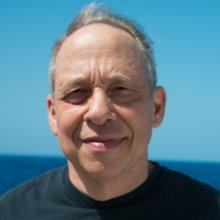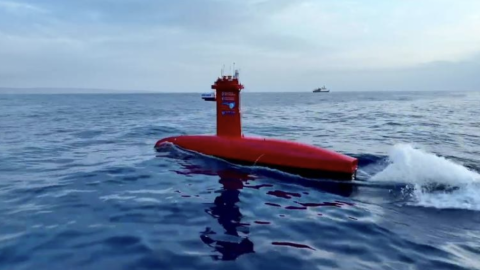
Dana Yoerger
Tell us about your work/research. What kinds of things do you do?
I work in robotics research. As part of that work, we design, develop, and operate robots for scientific applications. Robots I've worked with in the past include WHOI's Jason ROVs, ABE, Sentry, Nereus, and NUI. On this expedition, I'll be the expedition leader for the Mesobot group. Mesobot is a robot designed for midwater exploration. My role will include coordination with our science users, design of the dives, mission programming, real-time monitoring, and post-dive data analysis.
What sparked your initial interest in your career?
My family has always been attracted to the sea. I come from a family of shipbuilders who always lived and worked near the sea. I went on to study underwater robots as a PhD student at MIT. While I was a post-doc in the early 80s, my advisor invited me to meet with a guest from Woods Hole Oceanographic, Robert Ballard. Need I say more? Bob recruited me to join his group at WHOI and I've been there ever since.
Who influenced you or encouraged you the most?
My parents, no doubt.Raised in the Depression and during World War II, they did not have the opportunity to attend college. Their goal for my brother, sister, and I was that we have that chance. We all succeeded in that. I also had some great teachers in high school and in college in science, math, engineering, and the arts. On my second cruise with Dr. Ballard in 1985 we found Titanic. I have benefited enormously from my collaborative relationships with engineers and scientists from WHOI and other institutions from many countries (UK, France, Germany, Norway, Portugal, Japan, and China). Other scientists called my ideas "stupid" and considered our early robots "useless junk". I was sure we were right and those criticisms only motivated me more. We converted many of those scientists with our revolutionary results, like our first detailed maps of deep-sea spreading centers we made with our ABE robot. Some of those skeptics started writing excellent proposals that enabled us to take our robots to sea and make great discoveries.
What element of your work/study do you think is the most fascinating?
I think the most fascinating aspect of my work is the interactions between scientists and engineers. This is very much a two-way exchange. I like to think we take turns leading each other. Sometimes scientific requirements lead us to invent a new technology. Other times a technological concept leads to new ways of thinking about science. When I started, many scientists had no faith in remotely operated vehicles (ROVs) or autonomous underwater vehicles (AUVs) and considered my work a waste of money. A few, like Dr. Ballard, were aggressively trying to carry us into the future. Seeing that whole story unfold has been truly fascinating. Can we imagine deep sea science and exploration without ROVs and AUVs?
I also get most excited when we find new ways to use our robots to observe the ocean. Usually we succeed in the ways we expect, but the most interesting parts of my job is when we make observations we didn't know were possible or see things we didn't expect. I am most satisfied when a scientist sees our maps or images and says "that can't be right!". But it is!
What other jobs led you to your current career?
I have had only one real job in my entire career, scientist at Woods Hole Oceanographic Institution. I never wanted another one. Along the way, I worked at McDonald's in high school and as an engineering intern at the Draper Labs and for the State of Maryland Highway Department. As an undergrad and graduate student at MIT, I learned how to make things work and function as a member of a team. I spent the first few years at WHOI "learning the ropes" before I could start making meaningful contributions.
What are your degrees and certifications?
I hold Bachelors, Masters, and PhD degrees in Mechanical Engineering from MIT. I was named a Fellow of the IEEE in 2021.
What are your hobbies?
I walk in the woods almost every day. I like birding and I go cross-country skiing whenever I get the chance. I love my work so there's lots of crossover between my work and my personal time. I like learning about all branches of science. love music, especially popular music from my earlier years, and aspire to play the guitar. I have 4 children and 6 grandchildren. I am very proud of all of them and I enjoy spending time with them.
How did you get involved with the Ocean Exploration Trust?
I have worked with Dr Ballard for nearly 40 years, first at Woods Hole Oceanographic Institution and now with OET. WHOI, University of Rhode Island, OET, University of New Hampshire, and University of Southern Mississippi have a cooperative research program (OECI) funded through NOAA Ocean Exploration. As our OECI plans were evolving, my collaborators and I introduced Dr. Ballard to our emerging Mesobot technology and we were invited to join the OECI effort.
What advice would you give someone who wants to have a career like yours?
If you want a career working in and around the ocean, you can get there through many paths. The sciences are an obvious route but opportunities in engineering are even more abundant in my experience. For a career in research, you should concentrate on the basics as an undergraduate (engineering, physics, chemistry, biology, geology etc). You can take electives and do research projects related to the oceans. Graduate school is the right place to specialize in my opinion. Technical specialties like electronic circuit design, electrical power systems, mechanical design, mechatronics, and computer science can take you to a career in the ocean quicker than you might expect. OET does a great job of illustrating these opportunities to young people.
Unexpected discoveries are the best!
Expeditions
Dana participated in the following Ocean Exploration Trust expeditions:

